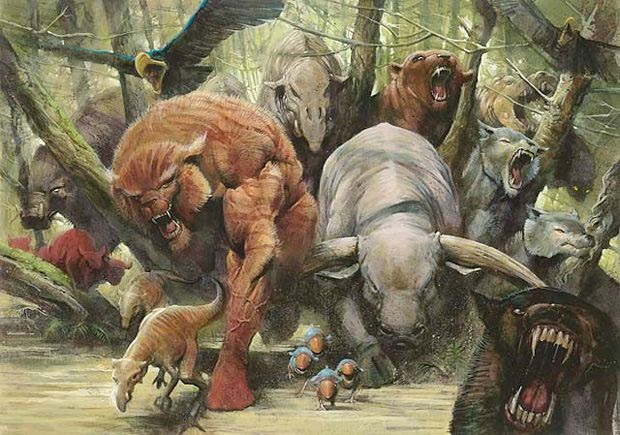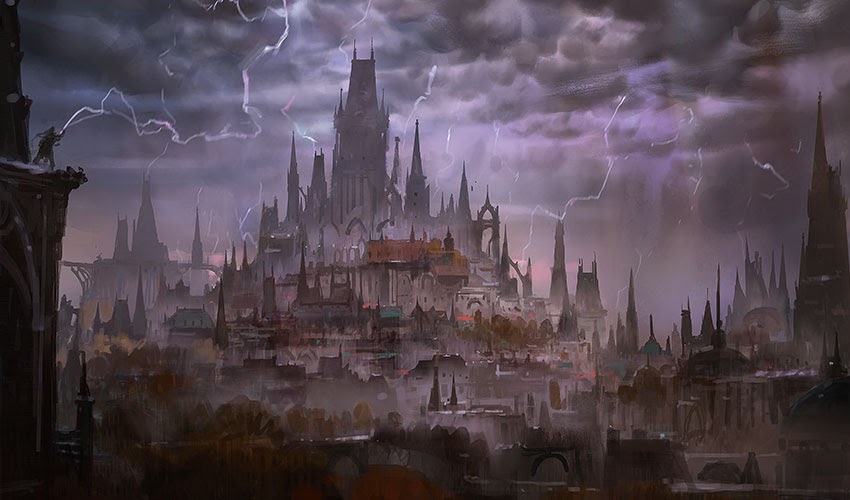Cover image: Knights’ Charge by Paul Scott Caravan
Commander is a wild, untamed landscape of creativity. Across the content sphere, there are plenty of resources on how to build and play your deck, but we don’t talk enough about how decks actually win. Today, we’ll begin to examine the various win conditions found in Commander. We’ll talk about how they work, and how your opponents will feel about facing them down. This will be the first half of a two-part article, and will cover the more common forms of victory in Magic: attacking, comboing off, or blowing the table away with powerful spells.
While there are many different ways to win in Commander, it’s important to pick at least one for each deck you build. If you don’t know how your deck wins, it can lead to a disorienting experience for both you and your opponents—like you’re doing all this work to get nowhere fast. Winning isn’t everything, but it pays to have a game plan. Let’s dive into what it takes to get across the finish line.

Overrun by Carl Critchlow
Creature Combat
Creatures provide the most straightforward way to win a game of Magic: attack until you reduce your opponent’s life total to zero. Unless you’re playing a creatureless deck with a planeswalker Commander, every deck has this as an option. It’s technically possible to have a deck full of zero-power creatures or walls that cannot attack, perhaps helmed by a Commander like Phenax, God of Deception; but even those decks can and do win some games by attacking for damage.
Attacking is one thing; actually dealing sufficient combat damage to win a game requires more than that. Typically, a deck will want to focus on one of two options: going wide, or going tall. “Going wide” refers to assembling a critical mass of creatures to overwhelm opposing blockers. They might be able to stop five goblin tokens, but not fifty. This is a common way to win in token decks, like Krenko, Mob Boss or Rhys the Redeemed. “Going tall” refers to having creatures that are bigger than your opponents. Since they still need to get through blockers, decks that go tall will want to give their threats some form of evasion, most commonly flying or trample. Cards like Overwhelming Stampede, Temur Battle Rage, or Distortion Strike can help a player crash through for lethal.
In this space, we also have commander damage and Infect. Both can end a game of Commander, but they’re less commonly played. Unless you’re on a dedicated Voltron deck that needs your commander to win, this damage is often a by-product of attacking. While there have been talks before about getting rid of commander damage, it still serves as a safety valve against infinite life combos.
As for Infect, it can be a touchy subject: a mechanic designed for 1v1 play, it was never adjusted for the higher life totals of Commander. But with the small breadth of Infect cards out there, it’s quite hard to deal 30 points of it in commander spread across three opponents—much harder than dealing 10 in Modern or Legacy. Infect decks in Commander will often use Proliferate effects to help speed up the process. While there are Infect specialists out there, these days we only really see Infect if someone casts Triumph of the Hordes. Fynn, the Fangbearer seems unlikely to change that, though we may see more actual infect creatures some time in the future.

Thousand-Year Storm by Dimitar Marinski
Infinite Combos
Commander has a fickle relationship with combo decks. While they’re an effective way to win games, they can lead to play patterns that some groups dislike. For instance, after a long, drawn-out battle, an infinite combo can make the game feel like it jumped to a hasty conclusion.
Infinite combos come in many different flavors. Generally speaking, the more pieces they require, the more likely a casual pod is going to be okay with them. On the flip side, two-card combos are much easier to assemble and play in a game. Their consistency offers a much different play experience than assembling a combo that looks like a Rube Goldberg machine. This sliding scale dictates a lot of how and where combo decks are played in the format.
When you run a card that goes infinite with your Commander, it’s essentially telling the table, “You have until this turn before I can potentially win.” Popular examples include running Helm of the Host in a Godo, Bandit Warlord deck, or Curiosity with Niv-Mizzet, the Firemind. While these combos are strong, some players won’t enjoy playing against them. These combos possess a sense of inevitability that singleton formats generally lack, especially since you always have access to one of the two pieces. This feeling is compounded if you run extra tutors to find the other piece. If both pieces are hiding in the 99, though, it makes the combo a tad more difficult to pull off.
The harder it is to win with your combo, the more likely your opponents are going to feel like they have a fighting chance against it. The more pieces a combo needs, the more chances your opponents have to disrupt it. For instance, my Darien, King of Kjeldor deck can gain infinite life with Darien, Blasting Station, and two life gain cards like Soul Warden and Ajani’s Welcome. But needing four pieces to go off means four potential angles of disruption, four cracks in the armor that my opponents can attack.
Finally, there are times when people discover a combo by accident. These kinds of moments are usually facilitated by a foundational card, like Dockside Extortionist or Lithoform Engine. A few other things will combine around them, and that player is off to the races. Since these results are often unintended, it can be understandable if someone accidentally wins a game like this.
It’s up to you to decide if that’s a direction you want to take. Some groups will flat-out say that they don’t want to play with infinite combos. No one is right or wrong here, because Commander is about the experience we create together. When in doubt, if you do plan on running combos in your decks, check with your group before the game begins, and gauge how people feel about them.

Expropriate by Zack Stella
“I Win” Cards
Commander is undoubtedly the home of big, splashy effects. With this come a host of cards that are designed to either win on the spot, or set a player up to win the following turn. For that reason, they’re often referred to as “I Win” cards. These days, these cards look like Expropriate, Craterhoof Behemoth, and Torment of Hailfire.
A lot of players have love/hate relationships with this type of win condition. On one hand, you have a powerful tool for closing out a game, which needs little build around to make work. On the other hand, they create predictable and linear games. With how common these haymakers are in Commander, it can feel like you’re compromising some of your deck’s creativity. But games have to end eventually, and these are surefire ways to make that happen.
Like with anything in Commander, there are strategy considerations to think about before playing one of these cards. If there aren’t that many creatures on the battlefield, you might want to hold up Insurrection for a few more turns. But if you wait too long, the board might get wiped before you can borrow everyone’s creatures. Or if you’re unsure about resolving Genesis Wave, you might want to put a little less mana into it, in order to formulate a backup plan. While one these cards can win a game on its own, having it stopped can leave you exposed to lose.
Ultimately, the choice is up to you if you want to run “I Win” cards in your deck. As someone who has played nearly all of them at one point, I believe they have their time and place. Sure, some folks roll their eyes at a late-game Cyclonic Rift, but sometimes that’s the break in parity that a game needs. These cards dislodge clogged board states, and can keep a game from dragging on past its welcome.
It’s important to remember that they don’t have to be from that list of standalone heavyweights. For instance, artifact-heavy decks might win off of Open the Vaults, or you could stack a deck full of permanents and cast Primal Surge. By leaning on a big, splashy effect that fits your deck’s theme, you can have both that flashy finish and have it be a part of your own personal flair.
Looking Ahead
These are some of the main ways to win in Commander, but it’s not an exhaustive list. Part 2 of this article will contain things like Prison, Mill, and alternative win conditions. There is truly something for everyone, so I invite you to join me next time.
Travis is a Virginia-based player and writer, who has been turning things sideways since Starter 1999. He primarily plays Commander, Pauper, and Legacy, and has a passion for introducing new players to the game. When he isn’t making people pay the Thalia tax, he can be found mountain biking or playing the guitar. You can follow his exploits here on Twitter and Instagram.

